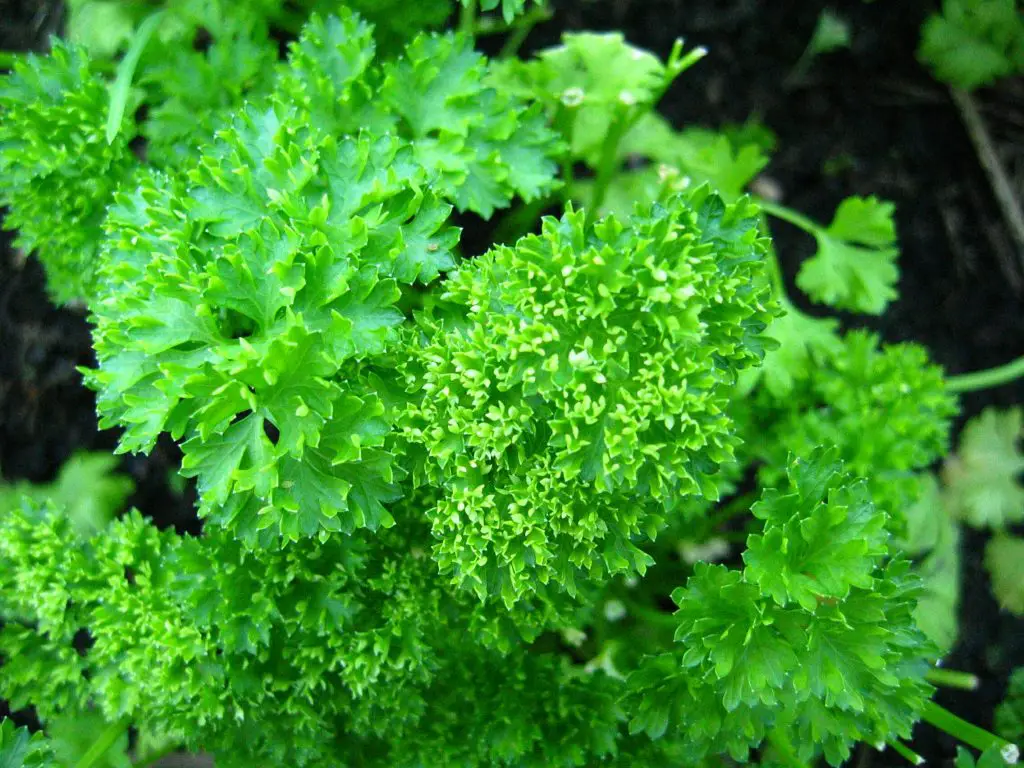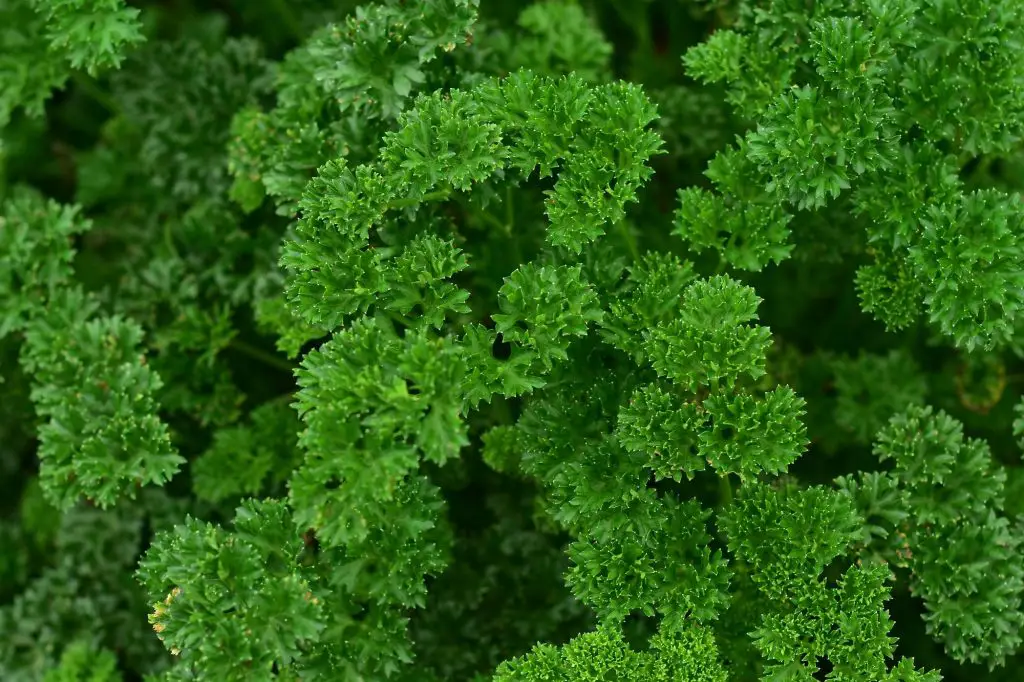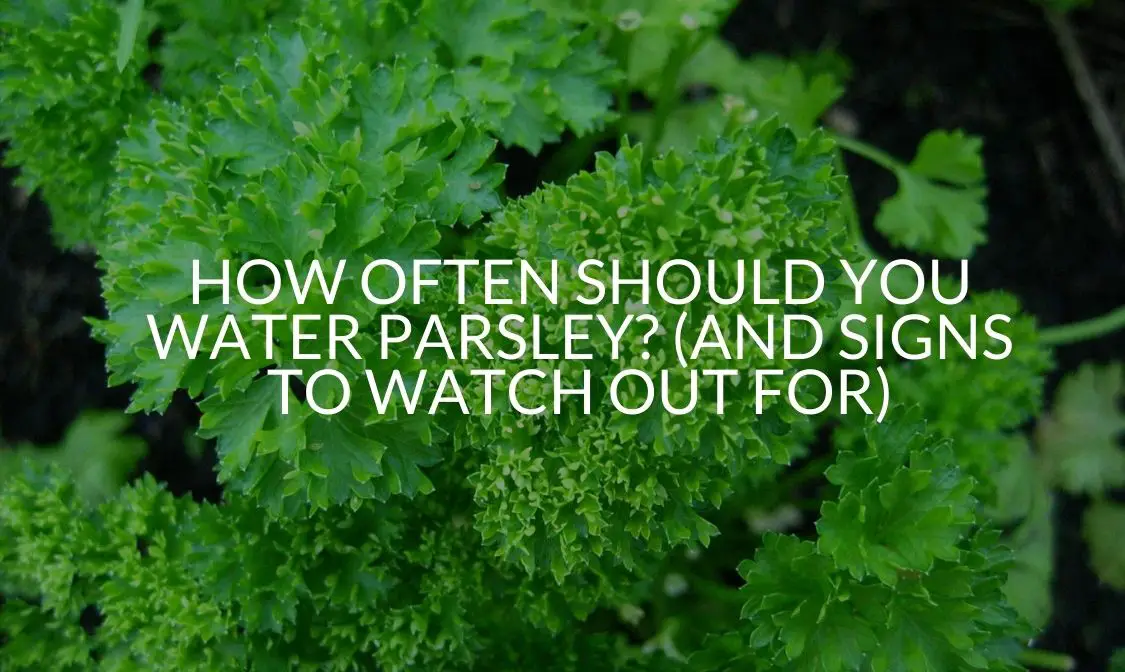You should water your parsley plants anywhere from once to three times a week. How often you should water parsley depends on different environmental factors, such as whether it’s in-ground or in a container, inside or outside, and how much sunlight is in the area.
The trick to knowing how much watering you need to do per week is to be aware of whether you are overwatering, which can cause discoloration of the leaves and an increase in pests, or underwatering, which can cause wilting and dry topsoil.
Keep reading this article to determine the best conditions for keeping your parsley plant well watered and what you can do if it’s getting too much or too little water.
How Often Should You Water Parsley?
Parsley needs watering 2 to 3 times a week. However, this depends on the conditions that your plant is living in.
Outdoor plants will need watering more often than indoor plants as they will be getting direct sunlight which can cause the soil to dry out faster. Whereas indoor plants can be watered as little as once per week since sunlight through windows will be diffused.
How Often Should You Water In-Ground Parsley?
A good soaking once a week should do the trick for in-ground parsley. It is essential to let the soil dry a bit between watering so that the parsley does not become overwatered. You might need to water in-ground parsley during drier weather twice a week so the soil doesn’t become completely dry.
To prevent a lack of water in your parsley, you might want to add mulch. Not only will this enrich the soil, but it will also conserve water and keep weeds at bay. Plastic mulch is also a good option if you live in an area where water is scarce as it lessens evaporation and does an excellent job of keeping weeds away.
How Often Should You Water Container Parsley?
For an outdoor container, how often to water your parsley depends on where you place the container. Parsley needs plenty of sunlight to grow well, but having your container in direct sunlight all day can cause the soil to dry quickly, so consider placing it somewhere that has shade for part of the day.
You should be watering an outdoor container 2 to 3 times a week, but check if the soil is dry regularly. Place a couple of fingers into the topsoil, and if it’s dry to the touch, then you should water your plant.
For an indoor container, you should water it deeply once a week as sunlight coming through a window is defused and will not dry out the soil as fast. You can always check if the topsoil is dry to the touch and decide whether more or less watering is required.
It would be best to have proper drainage for your containers, especially for an indoor container, that will allow excess water to drain out. Letting your parsley plant sit in overwatered soil for too long will cause the roots to rot and the plants to die.

What Are The Signs Of Overwatered Parsley?
If you notice that your parsley plants are drooping, but the soil is still wet, then chances are you are overwatering your plant.
If you have outdoor plants, it’s a good idea to consider how much water they are getting naturally through rainfall. You may find that some weeks with abnormally large amounts of rain, it is beneficial to bring your plants inside if possible to prevent overwatering.
If you can’t bring them inside, consider placing them somewhere with a covering or placing something like a tarp or tent over them until the soil starts to dry a bit.
Here are some signs of overwatering and some tips for how to rescue your plant before it’s too late.
Yellow Leaves
Yellowing leaves is not always a sign that your plant needs more water. It can also indicate that your parsley is getting more water than it needs.
Make sure that you are checking if the topsoil is dry before getting out your watering can. Don’t just check the very top of the soil but instead push your fingers at least an inch into the soil to determine how dry it is. Continuing to overwater a parsley plant that is already turning yellow will result in the roots rotting, which will eventually kill your plant.
Dark or Black Leaves
Overwatering your parsley can cause fungus and bacteria to take up residence in the moist soil. As they infect the plant, the leaves, followed by the stems and then the roots, will darken in color. An infection will usually start by turning the leaves brown before darkening further to black.
If this is beginning to happen to your plant, try moving it outside, if it isn’t outside already, to a place with plenty of sunlight to help dry out the soil.
If you suspect that any of your parsley plants have rotting roots, it’s best to remove them from the container or patch of the garden before they can negatively affect any of the other healthy plants.
Pests
A sign that you are overwatering could be an increase in insects in and around your parsley plants. Many insects are drawn to damp places and might lay their eggs there. Ensure that your planter or container drains extra water and checks any water pooling in the bottom.
Herbs like parsley have natural oils that can help keep away pests, but if you still have issues or want to keep the insects away while your plant filters out any extra water, you can try a few nontoxic things.
- Horticultural soap is a soup made from plant oils and can keep insects away without leaving harmful residues or harming beneficial insects.
- Canola oil can be a good insect repellent, especially if your parsley is already overwatered and you don’t want to spray the leave to stave off pests.
- Regular pruning. If you find that there are only insects on certain parts of the plant, then removing those sections could be enough to prevent further infestation.
Parsley can withstand some level of insects munching on it, and it’s almost impossible to prevent this from happening if your plants are outdoors entirely. Don’t panic if you notice the occasional pest hanging out on your plants. It’s only when there are many constantly attacking your parsley that you should take further action.
Mold
If you’re discovering mold on your parsley leaves, it could partly be because you are overwatering and the mold is thriving in the moist environment. Still, it could also be because you are watering the leaves instead of just the roots.
Make sure that when you are watering your plants, you aim for the roots to prevent moisture from building up on the leaves and ensuring that the water is getting to where it needs to be.
The only times you should sprinkle some water on the leaves of your plant is when dust and dirt are collecting there. Collecting dust and dirt will occur just over time or when there has been particularly dry weather and wind, causing more dust to be in the air.
Tips for Proper Drainage
Many issues associated with overwatering can be solved by either watering your plants less or making sure excess water is draining properly, so here are some quick tips to ensure water isn’t building up.
- Checking or adding drainage holes. Most store-bought containers already have the proper drainage holes in the bottom, but if you find you are still having issues, you can use a screwdriver or other pointed tool and enlarge the preexisting holes and add more.
- Don’t place containers directly on the ground. Water won’t drain out correctly if the drainage holes are blocked, so purchasing a planter with feet can help elevate it enough to allow excess water to get out. You might also want to get a planter caddy, enabling you to move the planter if needed.
- Prevent soil washing out. Placing some window screen or fabric that allows water to get out without taking the soil can ensure that drainage is happening without losing soil along the way. It can also prevent bugs from getting into the soil through the drainage holes.
In general, the more drainage for your container you have, the better. It’s much easier to keep track of when your parsley needs more water than to figure out whether the roots are drowning or rotting.

What Are The Signs Of Underwatered Parsley?
Wilting
One of the easiest ways to check if you are underwatering your parsley is to see if it is starting to wilt. In this case, simply giving it some water will do the trick, and it will soon be standing tall again.
However, wilting does not necessarily mean that your plant requires water, and can mean any number of things that are causing your plant not to be completely healthy, so be sure to check if the topsoil is dry or not before deciding to water it.
Cracked Soil
If there are apparent cracks in the topsoil, then your plant is in serious need of watering, but even something like the soil pulling back from the edges of the planter can be a sign that you should be watering your parsley more often.
Note that not all soil is the same and that parsley grows best in soil that drains well. Pick a soil that has a pH level of 6.0-7.0 to get the best results.
To better understand how best to start and care for your parsley plants, check out these guidelines from the University of Minnesota.
Drying Quickly
If you find yourself needing to water your parsley plant more than 2 to 3 times a week, then there’s a chance the planter or container the plant is in is too small to support how much water it needs. Try moving the plant into a bigger planter, and this problem should go away.
It’s always best to check for signs that your plant needs water rather than watering on a set schedule. Don’t be afraid to wait until you see your plant start to droop a bit before you check to see if the soil is dry. A good watering will perk your plant up, and a slight drooping will not harm the overall plant’s life.
A good rule to live by is to water deeply less often. If a good soaking once a week will be better for the overall health of your plant than a quick sprinkle multiple times a week.
Recap
Whether your parsley plants are inside or outside, in a planter or in-ground, the best way to know if it needs watering is to check if the topsoil has become dry. Watering your parsley plants 2 to 3 times a week is a good starting point, but as you get used to caring for your plant, you’ll have a better idea of what works.
It’s a good idea to consider whether to place your plants outside or inside before you plant your parsley. Think about how much rain your area gets and how much sunlight your plants will get in any outdoor spots you’re considering.
If keeping your plants inside is the only option, you’re going to need to water it less and keep an eye on it for any signs of overwatering. Even placing your plan out on an apartment balcony for some sunshine can make for a healthier plant.

